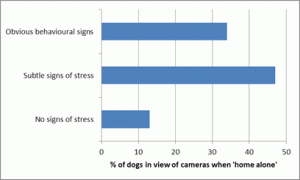Tagged: Dr Emily Blackwell
Left ‘home alone’: a welfare issue for dogs
Research over the past ten years with my colleague Dr Emily Blackwell and others at University of Bristol has highlighted just how common it is for dogs to have a negative response to being left home alone. Problem behaviours that dogs show when left alone are often described as separation anxiety, although we generally prefer to use the term ‘separation related behaviour’ (SRB). This is because dogs can show these behaviours for a number of reasons, and SRB is a ‘catch-all’ for dogs showing these signs (i.e. without implying that the cause is anxiety). Signs of SRB include barking, howling, destruction and toileting.
Our research has included owner surveys, where we have asked owners whether their dogs do things like bark, howl or scratch at the door when they are left at home alone. In these studies between 13% and 18% of owners reported that their dog showed some kind of separation related behaviour (SRB)1,2,3.
These surveys give us an idea of the problem – but they rely on owners knowing that their dogs show SRBs when they go out. This means that dog owners are only likely to report SRB if they come back to find some evidence of destruction, see that their dog has toileted, or hear from a neighbour that their pet was barking or howling. Suspecting that this was actually the tip of the iceberg in terms of what was going on for dogs themselves, we did a small study with the Blue Cross4 some years ago. This involved video recording dogs whose owners thought were fine to be left home alone – and found that a surprising proportion showed signs of SRB.
Building on this work, we have recently done a project which is featured in Channel 4’s ‘Dogs: Their Secret Lives’5. In this study, we video recorded 40 dogs in two Bristol postcodes when their owners went out of the house. We also collected saliva samples from the dogs both before and after they were left. This was to measure whether levels of cortisol, a hormone associated with the stress response, increased after dogs were left alone.
We expected to see quite a few dogs showing signs of SRB that owners were not aware of. We also thought there would be quite a few dogs showing more subtle signs of anxiety. But we were surprised by the numbers of dogs showing these signs in the group: the majority of the dogs in the population – over 80% – showed some negative response when left by their owners.
Two of the dogs in the study were excluded from the analysis because they were out of sight of the cameras for most of the time we filmed. But, as shown in Figure 1 below, only five of the remaining 38 dogs did not show behavioural or physiological indicators of stress when left alone. The rest of the dogs were divided into two groups. The first group was dogs which showed obvious behavioural signs – these included those that might be classified as having SRB, because they showed ‘problem behaviours’ such as barking or howling – but also included dogs which showed other ‘active’ responses, such as running between the window to look out and the door to listen for their owners’ return. Thirteen (34%) of the dogs were in this group. The other group of 18 dogs (47%) included those who did not show obvious or active behavioural signs – but clearly showed more subtle behavioural indicators of stress, such as postural indicators of anxiety.

Figure 1: The proportion of dogs which showed obvious, subtle and no signs of stress when recorded home alone
This was a small study, and more research is needed before the findings can be extrapolated to the wider dog population, but it does highlight the extent that being left alone can be a problem for dogs.
The numbers of dogs affected, together with the impact on the well-being of each individual animal, convinces me that this is one of the major welfare issues for domestic dogs in the modern world. I was therefore happy to see that is was made one of the top eight welfare priorities by the Advisory Council on the Welfare Issues of Dog Breeding6 (usually known as the Dog Advisory Council) in 2011. I am also pleased that Channel 4 is highlighting the extent to which this is a welfare issue for dogs in their documentary. It is an important problem, and rather sadly, one that is largely preventable if puppies are given appropriate early experience of being left alone.
You can find more information and advice about separation related behaviour in dogs by following this link to my web-site: http://vetbehaviour.info/dogs/separation-related-behaviours.html
References
- Bradshaw, J.W.S., Blackwell, E.J., Rooney, N.J. and Casey, R.A. (2002). Prevalence of separation related behaviour in dogs in southern England. In: Proceedings of the 8th ESVCE Meeting on Veterinary Behavioural Medicine, Granada, Spain. Eds. J. Dehasse, E. Biosca Marce. Publibook, France. Pp 189-193.
- Bradshaw, J.W.S., McPherson, J.A., Casey, R.A. and Larter, I.S. (2002). Aetiology of separation related behaviour in the domestic dog. Veterinary Record, 151, 43-46.
- Unpublished data on separation related behaviour prevalence, collected as a comparison for the occurrence of noise associated fears, reported in: Blackwell, E.J., Bradshaw, J.W.S. and Casey, R.A. (2013). Fear responses to noises in domestic dogs: Prevalence, risk factors and co-occurrence with other fear related behaviour. Applied Animal Behaviour Science, 145, 15-25.
- http://www.bluecross.org.uk/1958-2791/alone-at-home.html
- ‘Dogs: Their Secret Lives’ screened on Monday October 14th at 8pm, http://dogs.channel4.com
- Advisory Council on the Welfare Issues of Dog Breeding: The first eight welfare priorities

You must be logged in to post a comment.